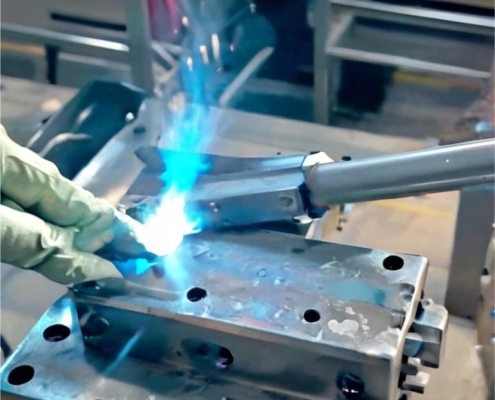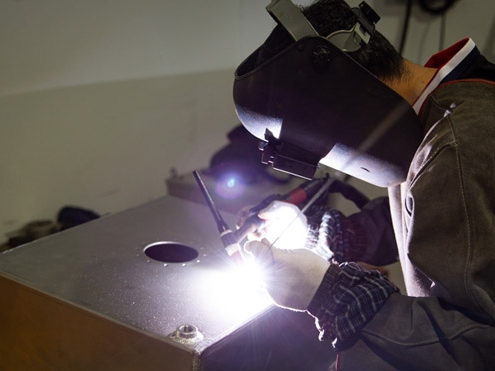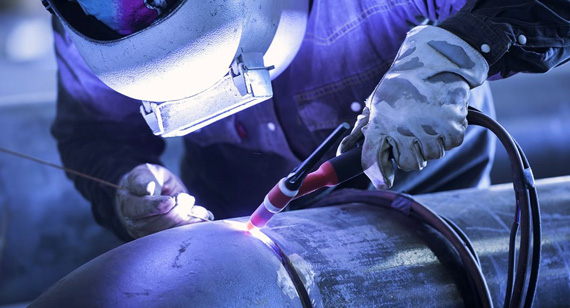What Is Tack Welding?
Tack welding is often seen as a minor step in the welding process, but it plays a crucial role in ensuring alignment, preventing distortion, and contributing to the overall strength of the weld. Ignoring this vital step can lead to significant problems, including weak joints, misalignment, and potential structural failures. Tack welding ensures that the parts stay in place and that the final weld will be accurate and strong.
Tack welding is a temporary technique used to hold parts in place before the final welding process. It helps ensure that parts are aligned properly and prevents movement during the full welding procedure, reducing the risk of defects. Tack welding is an essential step to achieving a precise, high-quality final product.
Now that we understand the basics of tack welding, let’s explore the process and its significance in more detail.
What is Tack Welding?
Tack welding is a technique used to temporarily join two or more pieces of metal, usually by making small, quick welds to hold the parts in position before the final weld is made. It is a key preparatory step in the welding process, ensuring the parts remain aligned during the full welding procedure.
Tack welding involves creating small, temporary welds that hold pieces of metal in place. This technique allows the welder to check the alignment and ensure that the components are in the correct position before proceeding with the final weld. It is particularly important when working with complex assemblies or large components.
In industries such as automotive and aerospace manufacturing, tack welding ensures that parts are properly aligned before they undergo full welding, preventing issues such as misalignment, distortion, and weak joints.

Why Is Tack Welding Important?
Tack welding is vital for guaranteeing that the final weld is strong, precise, and devoid of defects. It offers stability and mitigates the risk of distortion during the welding process.
In the absence of tack welding, components may become misaligned, resulting in inaccurate welds and potential structural vulnerabilities. This step is essential for preserving the integrity of the weld. While tack welding is frequently categorized as a preparatory phase, its influence on the overall quality of the final product can be significant. For instance, in the realm of automotive manufacturing, effective tack welding is crucial for ensuring that frames and components are aligned precisely prior to the completion of the full welding process.
How Is Tack Welding Done?
Tack welding is commonly executed through a range of welding techniques, which are determined by the materials involved and the specific demands of the project. The process entails applying a small, rapid weld at the joint to secure the components in position. It can be performed using MIG, TIG, or Stick welding methods, based on the type of metal being utilized.
In MIG and TIG welding, tack welds are created by delivering short bursts of heat, typically lasting just a few seconds, to temporarily join components. This method helps avert excessive heat from causing warping of the material while still ensuring that the parts are securely positioned.
Common Mistakes in Tack Welding
Although tack welding may appear simple, it is susceptible to mistakes that can jeopardize the quality of the weld. The following are common errors to avoid during the tack welding process:
1. Incorrect Heat Settings
One of the most prevalent errors in tack welding involves using incorrect heat settings. Excessive heat can lead to issues such as excessive spatter, warping, or burn-through, whereas insufficient heat results in weak penetration and inadequate fusion of the materials. It is crucial to ensure the appropriate heat range for the material being welded to achieve a strong and effective tack weld.
2. Poor Placement of Tack Welds
Inadequate placement of tack welds can result in misalignment of the workpieces. Such an error may lead to distortion, improper fitment, or uneven distribution of strength. It is imperative for welders to ensure that tack welds are positioned strategically to secure components effectively while not interfering with the final weld.
3. Insufficient Penetration
Insufficient penetration arises when the tack weld fails to adequately fuse the materials at the base. This results in a weak bond that may lead to failure during the application of the final weld. Ensuring proper penetration at the root of the weld is essential for achieving a robust and reliable tack weld.
4. Inconsistent Welding Speed
Maintaining a consistent speed during tack welding is essential for ensuring uniform bead size and strength. Speeding up or slowing down too much can result in underfilled or overfilled welds, leading to a weak bond.
5. Improper Cooling Time
Tack welds need time to cool properly before the final welding process begins. If a tack weld is too hot when the final weld is applied, it can cause distortions or cracks. Adequate cooling between tack welds is important to maintain the integrity of the entire weld.

What Are the Benefits of Tack Welding?
Tack welding provides crucial support during the welding process, helping to improve accuracy, reduce defects, and enhance the quality of the final weld. Below is a summary of its key benefits:
| Benefit | Description |
|---|---|
| Ensures Proper Alignment | Tack welds secure components in place, preventing movement and ensuring accurate positioning throughout the welding process for a precise final result. |
| Prevents Warping and Distortion | Tack welding minimizes distortion by distributing heat evenly and holding parts in place, especially important for large or thin materials. |
| Improves Final Weld Quality | With parts stabilized, tack welding allows for more precise and cleaner final welds, improving strength and consistency. |
| Reduces Cracking and Shrinkage | By controlling heat input and cooling, tack welds help manage thermal stresses, reducing the risk of cracks and excessive shrinkage. |
| Prevents Part Shifting | Tack welds hold components firmly during final welding, avoiding misalignment and reducing the need for rework or correction. |
Industries That Use Tack Welding
Tack welding is employed across multiple industries where precision, strength, and proper alignment are paramount. The following are some key industries that depend on tack welding:
1. Automotive Industry
In automotive manufacturing, tack welding is frequently utilized to temporarily secure components of the frame or body prior to the application of the final weld. This practice ensures that the parts are properly aligned, which is essential for maintaining the structural integrity and safety of the vehicle.
2. Aerospace Industry
In aerospace, tack welding is used to position and secure components like fuselage sections, wings, and other structural parts. Precise alignment is critical, as even the smallest misalignment can compromise the safety and performance of the aircraft.
3. Construction Industry
Tack welding is utilized in the construction of buildings, bridges, and other infrastructure projects. It serves to temporarily secure beams, supports, and various metal components before they undergo permanent welding. This approach ensures proper alignment and helps prevent distortion during the final welding process.
4. Manufacturing of Heavy Machinery
In heavy machinery manufacturing, tack welding is employed to guarantee the proper alignment of components prior to their permanent welding. This is particularly critical in large-scale machinery, where structural precision is vital for ensuring functionality and durability.
5. Energy Sector
Tack welding plays a role in the fabrication of energy infrastructure, such as power plants, reactors, and electrical equipment. It ensures that metal components are aligned and secured during the manufacturing process, contributing to the reliability and safety of energy systems.
What Is the Contrast Between Fabrication and Welding?
Fabrication and welding are inherently linked yet distinct processes. Fabrication encompasses the complete procedure of creating and assembling parts, which includes cutting, shaping, and joining materials. In contrast, welding specifically refers to the technique of joining two or more pieces of material through melting and fusing them together.

Although welding is a critical component of fabrication, the latter encompasses a wider array of activities, including cutting, bending, and assembling, in addition to welding. In many instances, welding serves as one of the concluding steps in the fabrication process, ensuring that the components are securely joined together.
In Conclusion
Tack welding is an essential process that guarantees proper alignment, minimizes distortion, and enhances the strength of the final weld across various applications, ranging from automotive to aerospace. This fundamental technique is crucial for attaining precise and high-quality welds.
Frequently Asked Questions About Tack Welding
What Is the Thinnest Steel That Can Be Welded?
The minimum thickness of steel that can be welded is influenced by both the welding process utilized and the proficiency of the welder. Generally, thin steel, such as sheet metal, can be effectively welded using tack welding, as this technique helps to mitigate distortion and prevent burn-through during the welding process.
Tack welding proves especially advantageous when dealing with thin materials, as it permits the welder to execute small, controlled welds that avoid overheating the material. This technique helps prevent burn-through, a common issue that may arise from the application of excessive heat to thin metal components.
What Types of Electrodes Should Be Used in Tack Welding?
The type of electrode used in tack welding depends on several factors, including the material being welded, the type of joint, and the welding method.
For tack welding, the most common electrodes are mild steel electrodes, which provide a stable arc and good penetration for most applications. Stainless steel electrodes are used when working with stainless steel materials, while flux-cored electrodes are preferred for welding thicker metals or materials prone to contamination.
The choice of electrode affects the quality and strength of the tack weld. It is essential to select the right electrode for the material being welded to ensure proper penetration, strength, and stability in the tack welds.
What Is Tack Riveting?
Tack riveting is a technique employed to temporarily join components using rivets prior to welding. It serves a purpose analogous to tack welding by securing the parts in position during the welding process, ensuring that they remain aligned and stable.
Tack riveting is especially valuable in scenarios where tack welding alone may not adequately secure parts together. For instance, in high-pressure environments or when welding large components, tack riveting can offer additional stability and help prevent movement during the welding process.



